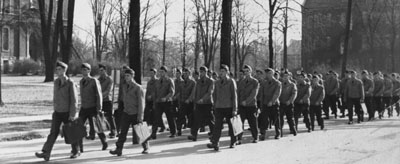
<<
Back
Professor
Jerome C. Hixson retired from the English department in 1967 after
43 years of teaching a variety of subjects, including one of the
most popular courses on campus called, "Living Language."
He taught a few more years on a part-time basis before moving to
Englewood, Florida, where he resides presently with his wife Margaret.
In his memoir, Past Perfect, he describes his experiences teaching
physics to the young men of the Navy Flight Preparatory School (V-5).

________________________________
Professor Jerome Hixson, 1927-67.
____________________________________
When the first classes started on January 1, 1943, the cadets did
not have uniforms and other equipment. Many were marched into their
classes by platoon leaders, all in civilian dress; but gradually
military shoes, blouses, and other recognizable pieces of equipment
appeared until the campus began to take on more of a military appearance.
Of course for the remaining students, mostly women, regular classes
went on as usual but not in Asbury Hall. They soon became familiar
with the "one-two, one-two" as the cadets marched between
Longden and Asbury, and to the athletic field. The cadets had no
leisure time for social activities: they attended academic classes
48 hours a week, eight hours a day, six days in the week. The only
way whereby Flight School could cover the required work was by strict
attention to business. Christmas Day was a holiday only because
the day's work was made up by extra classes on other days.
Inexorably, the examinations came under seal from Annapolis regularly
each week. Inexorably, the weekly tests (4.0 was top) separated
the fit from the unfit. On each crucial Saturday many cadets left
offerings of pennies on the statue of Abraham Lincoln, then in the
corridor of Asbury, in the hope of success so that they would not
be "washed out" and lose all hope of becoming a flight
officer...
Not only were uniforms and pieces of equipment lacking at the outset,
but more seriously the rapidly assembled staff was obliged to plan
and give courses before textbooks arrived. For example in the physics
course which I was asked to give (on the basis of national emergency),
we had to present the subjects of motion, heat, light, electricity,
and sound with only a bare outline...
Early in the program a problem developed. Cadets became so appreciative
of their instructors' work that some of them started presenting
gifts such as hand-luggage. Of course, this had to be stopped. The
instructors were only doing their duty. The sheer objectivity of
the military regime completely obviated any dangers of favoritism.
There was an inexorability in the impersonal questions which came
in sealed envelopes from Annapolis and which were graded by machine...
Despite the necessary wartime regimentation in the V-5 school, there
was some irrepressible fun. This happened in one of Reid Winsey's
classes in flight. After the cadets had been marched into place
by their platoon leader, the room was darkened for the showing of
the film strips which were used in this and other branches of instruction.
The warm, dark room provided an irresistable opportunity for needed
rest. One cadet removed his military shoes and went to sleep on
the back row. At the end of the hour, when the bell rang for the
class to march out into the hall ... this unfortunate cadet could
not find his shoes. Some comrade with a dry sense of humor had thrown
them out the window, and the luckless youth had to march as best
he could without them, hoping not to be disciplined!

__________________________________________________
The V-5 unit of the Naval Flight Preparatory
School marching
down College Avenue to class in Asbury Hall. By its end in
1944,
2464 men had completed the three month training program at DePauw.
_________________________________________________________
Back
to Top
<<
Back
|



